Human body balance function quantitative evaluation system
A quantitative evaluation and quantitative evaluation technology, applied in the field of biomechanics, can solve problems such as loss of interest in rehabilitation exercise, difficulty in measuring the degree of rehabilitation of patients, inability to provide quantitative indicators, etc., to achieve the effect of excellent portability
- Summary
- Abstract
- Description
- Claims
- Application Information
AI Technical Summary
Problems solved by technology
Method used
Image
Examples
example 1
[0090] Such as figure 1 As shown, the embodiment provides a quantitative evaluation system for human body balance function, which is composed of an acceleration sensing module M1, a body movement posture detection module M2, a display interaction module M3 and a balance ability evaluation module M4.
[0091] Step 1: Game initial parameter setting.
[0092] The user selects the initial parameters of the game by setting the initialization module M33. There are two initial game parameters that need to be selected, namely game mode and game difficulty. With the help of an external handwriting input board, the user selects the game mode parameter Mode1 and the game difficulty parameter Level1. In this mode, the user needs to wear the 5-way sensor group F i , (i=1, 2, . . . , 5) perform simple static aiming tasks.
[0093] Step 2: Wear the acceleration sensor group.
[0094] The user sets the 5-way acceleration sensor group F i , (i=1, 2, ..., 5) are respectively worn on the ab...
example 2
[0148] Such as figure 1 As shown, the embodiment provides a quantitative evaluation system of human body balance function, which is composed of an acceleration sensing module M1, a body movement posture detection module M2, a display interaction module M3 and a balance ability evaluation module M4.
[0149] Step 1: Game initial parameter setting.
[0150] The user selects the initial parameters of the game by setting the initialization module M33. There are two initial game parameters that need to be set, namely game mode and game difficulty. With the help of an external keyboard, the user selects the game mode parameter Mode1 and the game difficulty parameter Level2. In this mode, the user needs to wear the 5-way sensor group F i , (i=1, 2, . . . , 5) perform dynamic tracking aiming tasks.
[0151] Step 2: Wear the acceleration sensor group.
[0152] The user sets the 5-way acceleration sensor group F i , (i=1, 2, ..., 5) are respectively worn on the abdominal core muscl...
example 3
[0199] Such as figure 1 As shown, the embodiment provides a quantitative evaluation system of human body balance function, which is composed of an acceleration sensing module M1, a body movement posture detection module M2, a display interaction module M3 and a balance ability evaluation module M4.
[0200] Step 1: Game initial parameter setting.
[0201] The user selects the initial parameters of the game by setting the initialization module M33. There are two initial game parameters that need to be selected, namely game mode and game difficulty. With the help of a smart phone connected to the evaluation system through a local area network, the user selects the game mode parameter Mode2 and the game difficulty parameter Level1. In this mode, the user needs to wear a sensor group F 1 Perform simple static aiming tasks.
[0202] Step 2: Wear the acceleration sensor group.
[0203] The user sets the 1-way acceleration sensor group F 1 It is worn on the right ankle joint of ...
PUM
 Login to View More
Login to View More Abstract
Description
Claims
Application Information
 Login to View More
Login to View More - R&D
- Intellectual Property
- Life Sciences
- Materials
- Tech Scout
- Unparalleled Data Quality
- Higher Quality Content
- 60% Fewer Hallucinations
Browse by: Latest US Patents, China's latest patents, Technical Efficacy Thesaurus, Application Domain, Technology Topic, Popular Technical Reports.
© 2025 PatSnap. All rights reserved.Legal|Privacy policy|Modern Slavery Act Transparency Statement|Sitemap|About US| Contact US: help@patsnap.com



